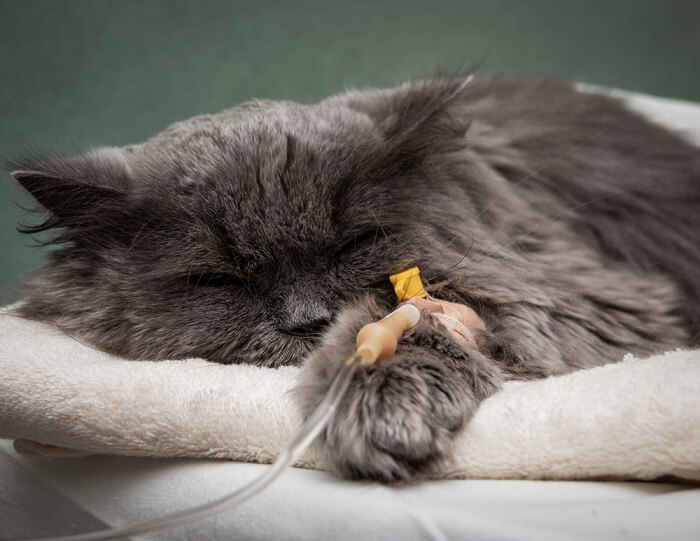
A diagnosis of liver cancer, or even the suspicion of liver cancer, is a scary moment for any pet owner. Even as your veterinarian is gathering information, your mind is probably already racing ahead to “what’s next?” and “how much longer will my cat survive?”
Fortunately, although liver cancer in cats is a serious condition, it isn’t always a death sentence. In fact, some liver tumors are benign masses for which surgery is curative. A thorough diagnostic workup will allow your veterinarian to determine the cause of your cat’s liver cancer and recommended treatments.
What Is Liver Cancer in Cats?
The term “liver cancer” (or hepatic neoplasia) refers to any tumor within the liver. These masses may occur within the liver tissue itself, in the gallbladder, or in the bile duct. Regardless of their location, all liver tumors can interfere with the liver’s normal function, leading to clinical signs of liver failure.
Liver cancer is categorized based upon two criteria: its distribution and its origin.
A solitary liver mass is a single, discrete tumor, which may be able to be removed surgically. Nodular liver cancer consists of multiple small nodules, distributed throughout the liver.
Diffuse liver cancer affects the liver tissue diffusely, instead of being confined to discrete nodules or masses. Solitary masses can sometimes be removed surgically, while nodular or diffuse liver cancer are more difficult to treat.
Liver cancer can arise in two ways. Some liver tumors, known as primary liver tumors, arise directly from the liver tissues. Other liver tumors, known as metastatic liver tumors, have spread from a malignant tumor that originated elsewhere in the body. Primary liver tumors are generally easier to manage and treat than metastatic liver tumors.
Causes of Liver Cancer
Primary liver tumors arise directly from the liver tissue. The most common primary liver tumor in cats is a bile duct adenoma (also known as a biliary cystadenoma). This benign growth originates from the bile duct.
Fortunately, these bile duct adenomas can typically be entirely cured through surgical removal. Other, less common, primary liver tumors in cats include bile duct carcinoma, hepatocellular carcinoma, myelolipoma, fibrosarcoma, hemangiosarcoma, and carcinoid tumors. These tumors cannot typically be cured with surgery and are associated with a worse prognosis than a bile duct adenoma.
More commonly, feline liver tumors are metastatic liver tumors. These tumors have spread, or metastasized, from another region of the body.
In cats, common sites of metastasis include the intestines, spleen, and pancreas; malignant tumors that develop in these locations often spread to the liver if they are not diagnosed and treated early. The liver is also frequently involved in feline lymphoma, which is widespread metastatic cancer that can affect organs throughout the body.
Symptoms of Liver Cancer

While some cats with liver cancer show no symptoms at all, others exhibit symptoms of illness. Because not all cats show symptoms of disease, the cancer is often detected during the workup of another condition.
Cats with liver cancer can demonstrate a wide variety of clinical signs of disease. Some cats are completely asymptomatic and their liver cancer is detected as an incidental finding during the workup of another condition.
For example, an apparently healthy cat may present for a routine dental cleaning and the veterinarian may notice severe liver enzyme elevations on pre-anesthetic bloodwork.
These liver enzyme elevations may suggest the presence of liver disease and further investigation may lead to a diagnosis of liver cancer, even in a cat with no signs of illness.
Some cats with liver cancer demonstrate obvious clinical signs of liver dysfunction, which can range from mild to severe.
Signs of liver disease in cats include decreased appetite, weight loss, and vomiting. Affected cats may also have increased thirst and urination. In severe cases, cats may develop yellowing of the skin, eyes, and gums (known as jaundice or icterus).
Neurologic signs, such as stumbling, disorientation, and seizures, may also be observed. If a liver tumor ruptures and bleeds within the abdomen, the cat may become acutely weak or collapse, with pale gums due to blood loss.
Diagnosis of Liver Cancer in Cats
The clinical signs of liver cancer are typically indistinguishable from other liver diseases, such as liver infection, inflammatory hepatitis, and gallbladder disease. Therefore, your veterinarian will need to perform a thorough diagnostic workup to determine the cause of your cat’s liver dysfunction.
The first step in addressing potential liver disease is a thorough physical exam.
Your veterinarian will perform a complete head-to-tail exam of your cat, including palpation of the abdomen. If your cat has a large, solitary liver tumor, your veterinarian may be able to feel this mass within the abdomen. Your veterinarian will also examine your cat carefully for signs of jaundice, as well as other signs of liver disease or other illnesses.
Blood tests, including a complete blood cell count and serum biochemistry, will also be performed.
Elevations in your cat’s liver enzymes, including alkaline phosphatase (ALP), alanine transferase (ALT), aspartame aminotransferase (AST), and gamma glutamyl transferase (GGT), are often the first indications of liver disease. Other bloodwork abnormalities may also be observed, depending upon the underlying disease.
If laboratory tests suggest that your cat liver disease, imaging is often the next step.
Abdominal radiographs (x-rays) are often used as a first step to assess a cat’s liver. Radiographs allow your veterinarian to see the size of your cat’s liver, as well as to look for large or obvious tumors.
Abdominal ultrasound may also be used to provide further imaging of the liver, because it provides a three-dimensional view of the liver’s internal structure. Ultrasound can also be used to locate small masses and to look for stones within the gallbladder and bile duct.
When suspected liver tumors are seen on ultrasound, more specific diagnostics are often needed.
Depending on the mass and how accessible it is, your veterinarian may recommend a fine needle aspirate (in which a small number of liver cells are removed using a thin needle), a needle biopsy (in which a small plug of tissue is removed using a large-bore needle), or a surgical biopsy (in which a larger chunk of liver tissue is surgically removed) of the liver or its adjacent lymph nodes.
Each of these tests is designed to remove a small sample of cells or tissues from the suspected liver mass. These cells are examined by a pathologist, using a microscope, in order to arrive at a definitive diagnosis.
An accurate diagnosis is required in order to understand your cat’s prognosis (expected outcome) and determine the best course of treatment.
Liver Cancer in Cats Treatment

The treatment of liver cancer usually involves surgery or, occasionally, chemotherapy. The type of treatment in your cat’s case will depend on the type of tumor they have.
The treatment of liver cancer depends largely on the type of tumor that is present.
In the case of a solitary primary liver tumor, the best treatment is surgery. The veterinarian will make an incision in your pet’s abdomen (belly), in order to access the liver.
The mass will then be cut away from healthy liver tissue. The defect in your cat’s liver will be closed with suture or surgical staples. The incision in your cat’s body wall will also be closed with suture or staples.
If the removed tumor is of a type that is sensitive to chemotherapy, your veterinarian may recommend chemotherapy treatments.
If your cat’s liver cancer has metastasized from elsewhere, the treatment will depend upon the particular type of metastatic tumor.
Surgery is not typically recommended for tumors that have already metastasized, but chemotherapy and/or radiation therapy may be beneficial. A veterinary oncologist will help you determine the best treatment for your cat.
Conclusion
Liver cancer is a serious disease in cats. There are many possible causes of feline liver cancer, which makes obtaining an accurate diagnosis essential in order to understand your cat’s prognosis and determine an appropriate treatment plan.
Work with your veterinarian to determine which tests and procedures are necessary to diagnose the cause of your cat’s liver cancer, in order to put together the most effective treatment plan possible.







